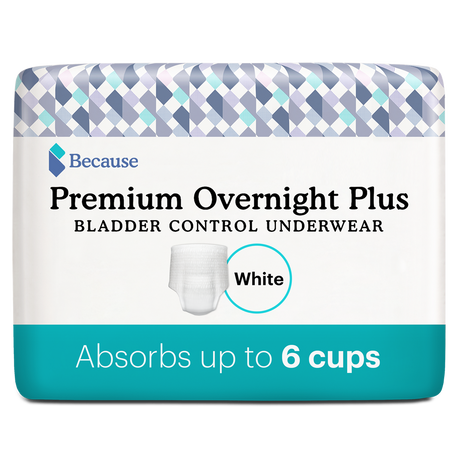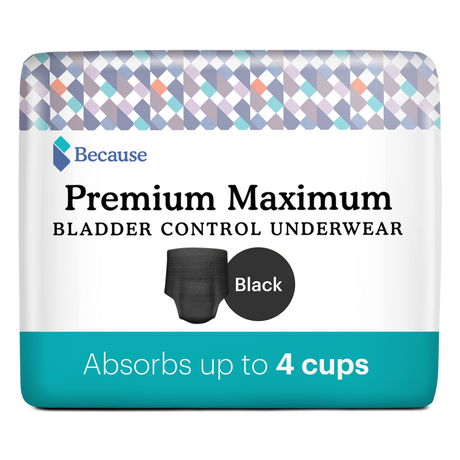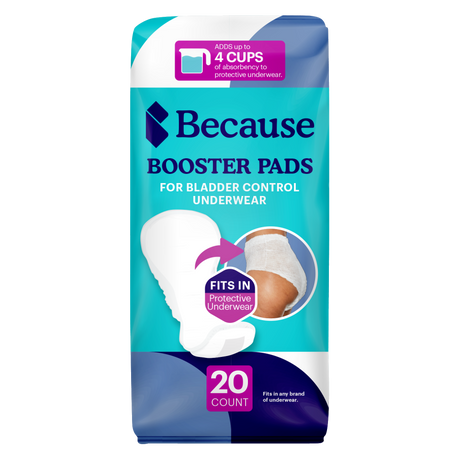Medically reviewed by Dr. Kerac Falk, MD, FACOG.
Urethral dilation is a relatively common procedure to treat scar tissue in the urethra. Although it’s minimally invasive, urethral dilation can sometimes cause side effects just like other surgical procedures. If your healthcare provider has recommended urethral dilation, you may wonder if you’ll need to worry about incontinence afterward. Read on to get the facts about incontinence after urethral dilation.

Does Urethral Dilation Cause Incontinence?
Urinary incontinence is a possible side effect of urethral dilation. However, it is not common. Patients are much more likely to experience other side effects like pain and blood in urine following the procedure.
What Is Urethral Dilation?
During a urethral dilation, a doctor widens the urethra, the tube that carries urine out of the body. In men, the urethra is found inside of the penis. The location of the urethra in women is between the labia below the clitoris and above the opening of the vagina.
A physician can use three different techniques to perform a urethral dilation. The first option is to insert a series of long, thin rods called sounds. Alternatively, they may utilize a balloon dilator, a special balloon that gets inserted into the urethra and then is gradually inflated.
The final type of urethral dilation is known as a urethrotomy. This procedure involves inserting a thin tube called a cystoscope into the urethra. A tiny camera at the end allows the doctor to see the inside of the urethra. While viewing the images, the doctor uses a tiny scalpel mounted on the cystoscope to make an endoscopic incision and cut away some tissue from the inside of the urethra.
Before the procedure begins, the person may be placed under general anesthesia, or the urethra may be injected with a numbing agent to dull the sensation.
The entire procedure takes less than one hour to complete. However, the actual appointment will be longer to allow for prep and recovery. Most people return home on the same day.
In some cases, you may need to use a urinary catheter for the first few days after the procedure. A catheter is a tube that allows urine to drain out of the bladder.

Common Indications for Urethral Dilation
Doctors typically perform urethral dilation to treat urethral strictures, scar tissue that develops in the urethra. The scar tissue causes a narrowing of the urethra that restricts the flow of urine.
Common symptoms of urethral stricture disease include:
- Difficulty urinating
- Painful urination
- Recurring urinary tract infections
- Inflammation of the prostate in men
- Urinary retention, or a complete inability to urinate
What Causes Urethral Stricture?
Scar tissue forms in the urethra for a number of reasons. Some common causes include:
- Injuries that cause trauma to the penis, scrotum, or perineum in men or the genital area in women
- Sexually transmitted infections, such as chlamydia
- Complications of previous surgical procedures performed on the urethra
- Previous use of catheters
- Inflammatory diseases
- Estrogen deficiency in women
In some cases, doctors cannot determine the cause of the condition. When no injury or medical condition can be identified as causing the stricture, healthcare providers refer to it as idiopathic urinary stricture.
The male urethra is significantly longer than the female urethra, and the longer urethra puts men at higher risk for developing urethral strictures than women.
How Is Urethral Stricture Diagnosed?
To diagnose urethral stricture, doctors may first perform a physical exam and then order blood work and a urine culture to rule out infections and underlying medical conditions. They may also order imaging tests like an ultrasound or CT scan. Other tests used to diagnose urinary stricture include cystoscopy and the retrograde urethrogram, which involves squirting a contrast dye into the tip of the penis and then taking x-rays of the urethra.
 Urethral Dilation Procedure and Potential Side Effects
Urethral Dilation Procedure and Potential Side Effects
For some people, urethral dilation is an effective treatment for urethral strictures. However, how much scar tissue is present impacts the effectiveness. The overall success rate for treating strictures less than two centimeters in length is 60%. Even when the procedure is initially successful, the scar tissue may return over the long term. When this occurs, it may be necessary to repeat the dilation or for the person to undergo a different type of surgery.
The most common side effects of urethral stricture are pain, burning during urination, and blood in urine. People who use catheters following the procedure may also experience bladder spasms. There is also a risk of developing a urinary tract infection after a dilation.
The Connection Between Urethral Dilation and Urinary Incontinence
During a urethral dilation, the external urethral sphincter, the muscle that opens to allow urine to exit the urinary tract when you urinate, can become weakened. The weakness can allow urine to leak out. The good news is that problems with urinary incontinence after the procedure typically resolve on their own. Urethral dilation is unlikely to cause permanent incontinence, and even temporary short-term incontinence is a rare side effect.

Factors That May Increase the Risk of Incontinence With Urethral Dilation
How likely a person is to experience accidental urine flow after a urethral dilation depends on a number of factors, including how complex the procedure is and the severity of the stricture. Research studies haven’t established any universal risk factors for incontinence post-dilation in males or females. Your urologist can discuss the short- and long-term outcomes and risks of the procedure with you.
Management and Treatment Options for Side Effects of Urethral Dilation
Individuals who do develop incontinence and other side effects after a urethral dilation can take steps to address symptoms at home. Let’s look at some of the things that you can do to feel better and support your urinary health during the recovery period.
Self-Care
After the procedure, your healthcare provider will give you a patient education guide with instructions on what you should do to care for yourself at home. Your doctor may advise you to:

Pelvic Floor Exercises
Strengthening the muscles that support the urinary bladder and the rest of the lower urinary tract may help to reduce incontinence. Kegels are one of the most commonly recommended bladder control exercises, which involve tightening your pelvic floor muscles for three seconds then releasing and resting for three seconds. Often, the best results come from learning exercises and relaxation from a specialized pelvic floor physical therapist.
Dietary Changes
Diet plays an important role in health and well-being. You’ll typically be able to return to your usual diet right away following a urinary dilation procedure. However, you may wish to avoid foods that could potentially irritate your bladder if you develop incontinence. Some foods and drinks that can cause bladder irritation include:

You may find that you experience more urinary discomfort when you eat some of the above foods, but that you don’t when you consume others. Keeping a food diary where you track what you eat and what symptoms you experience can help you identify foods and drinks to avoid while managing incontinence.
Incontinence Protection
Incontinence protection products can help you stay dry until incontinence resolves. There are two main kinds of incontinence protection: incontinence pads and incontinence underwear.
An incontinence pad is an absorbent pad that you wear inside of your usual underwear. Also called adult diapers, incontinence underwear takes the place of your usual undergarments. Follow these tips when choosing incontinence products to get the best option for your needs:
- Choose a gender-specific product: Due to differences in the location of the urethra, men and women have different needs when it comes to protection. Men’s products are typically more absorbent in the front, while women’s have extra absorbent material through the front and middle.
- Consider size: Incontinence pads are generally one size fits all, but incontinence underwear comes in different sizes. Measure yourself and consult the size chart to get the right fit.
- Get the right absorbency: Incontinence products come in different levels of absorbency, including moderate, maximum, and overnight. Each absorbency level can hold up to a certain number of ounces of urine. For more severe incontinence symptoms, higher absorbency products are the best option.
Incontinence Hygiene
Practicing good personal hygiene can help to control incontinence odors and support healthy skin. Follow these hygiene tips to care for yourself while dealing with dilation-related incontinence:
- Wash your hands before and after you change your incontinence protection.
- Change your pad or underwear as soon as possible when leakage occurs.
- Thoroughly cleanse your skin with mild soap and water, a no-rinse cleansing spray, or cleansing wipes when you change your incontinence protection.
- Apply barrier cream to your private area to protect your skin from moisture.
- Put used incontinence products in disposal bags before throwing them away.

Medications
Pain associated with urethral dilation typically resolves after several days. In the meantime, you may be able to take over-the-counter non-steroidal anti-inflammatory drugs (NSAIDs) like ibuprofen or naproxen. Although these medications are available without a prescription, consult your healthcare provider before taking them to relieve pain following dilation.
Discuss Side Effects With Your Healthcare Provider
If you experience any of the following symptoms after urethral dilation, contact your healthcare provider promptly:
- Inability to urinate
- Clogged catheter
- Fever or chills
- Swelling
- Worsening pain
You can also discuss more mild symptoms like urinary incontinence with your healthcare provider to learn if there are other ways that you can address them.
Are you struggling with incontinence after urethral dilation? Take our bladder protection quiz and get a sample pack to try.
About the Expert:
Dr. Falk is a fellowship-trained urogynecology subspecialist, double board-certified in both Obstetrics and Gynecology, as well as Female Pelvic Medicine and Reconstructive Surgery. He has expertise in the treatment of female pelvic floor disorders, which encompass many common but infrequently-discussed conditions which significantly impact women’s quality of life. These include complex disorders such as urinary and bowel incontinence, pelvic organ prolapse, childbirth injury, genital fistulas, recurrent urinary tract infection, and bladder pain.
Source:
Cleveland Clinic. (n.d.). Urethral Dilation. https://my.clevelandclinic.org/health/diagnostics/25044-urethral-dilation









